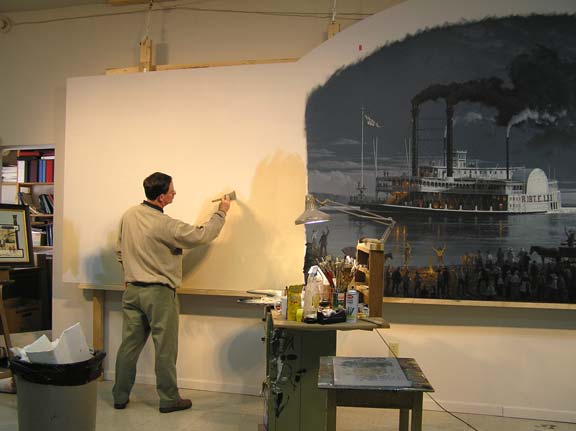

The center section of the mural is complete. Time to move on to the rest of the painting. Above, I am beginning the under painting by toning the area that will in time become a map of the Mississippi River.
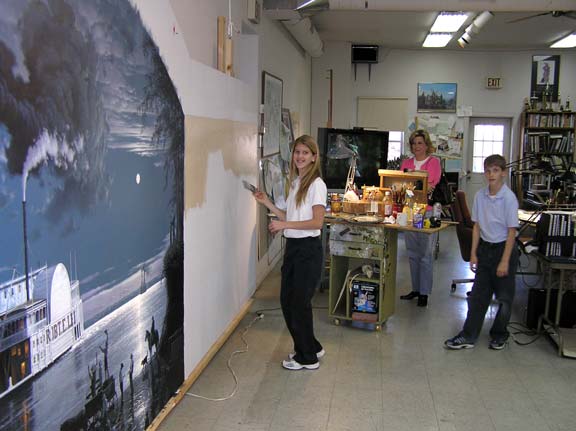
As remembered in the Tom Sawyer theme, maybe I can get some unsuspecting help from these local passers-by. My friends and models for the mural, Anna and Andrew Fischer with their Mom, Nancy in the background, are picking up a brush and spreading a little paint. Anna and Andrew modeled for the fishermen in the lower right-hand corner of the mural. See my first journal entry and the study for the painting to see these two in action. Andrew got to paint on the left side of the mural; however, I didn't get a photo.
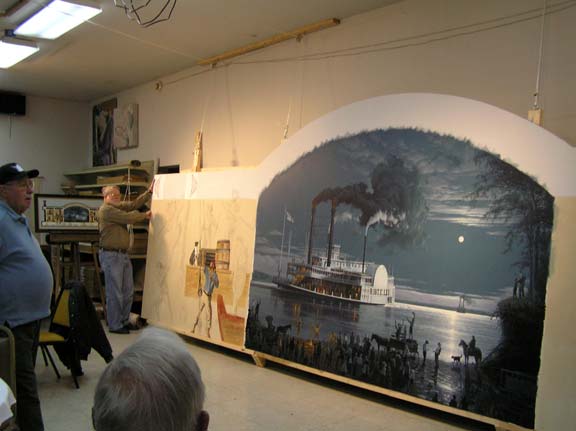
With the side panels under painted, and work started on the left side, an anticipated problem is right on time. If you have ever hand washed a sweater, you will remember that as the sweater becomes wet it becomes larger, it swells. As paint is applied to this large piece of canvas the same thing happens to the canvas. The combination of pounding with a brush, additional weight of the paint, and the paint volume being absorbed between the woven fibers of the canvas causes the canvas to swell and become loose. I completed a mural for the Bank of West Plains, Wests Plains, Missouri, in the late 70's. This problem developed at the same time as the mural of today. I had anticipated the problem then, and, the tightening of the canvas worked like a charm. Time to call out my coffee shop friends and move the mural into position to see if my new and improved canvas stretchers were up to the task.
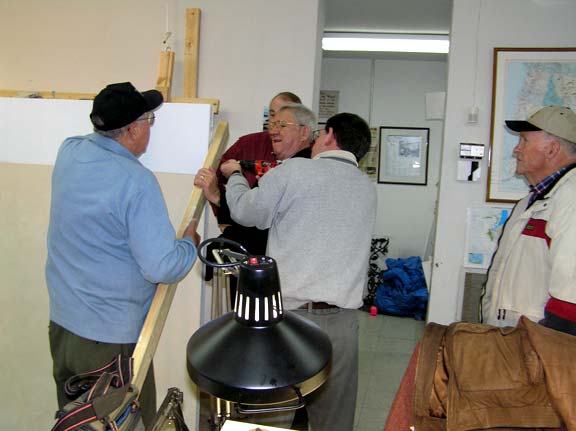
The mural is taken off the easel and moved about five feet from the wall to give me some room to work. Yes, that is Sid Thayer holding the 2x4. It is rumored the Sid has never engaged in manual labor. This photo proves that myth to be wrong.

Once my friends have been thanked for their help and have moved on to their daily duties, I begin to tighten the canvas. This is new territory for me. My mural in 1978 was a rectangle. However, this painting has the arch in the center. When I put pressure on the canvas to tighten it, would I get wrinkles in the canvas where the round section met the top of the canvas stretchers? I didn't know. It is one of those "will it happen in reality the way it works on paper" moments.
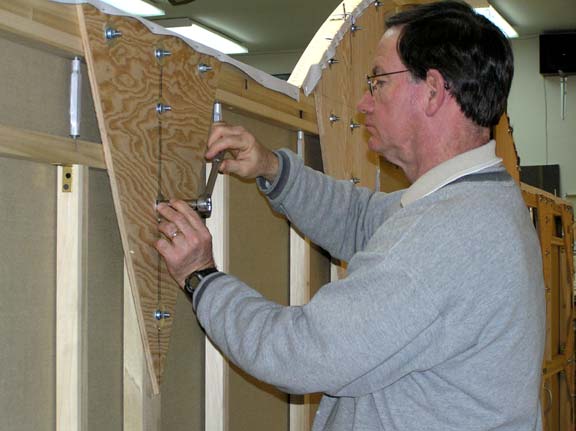
The triangular pieces on the back are braces and expansion joints. As above, I went around the whole canvas stretcher system and loosened all the expansion joints.
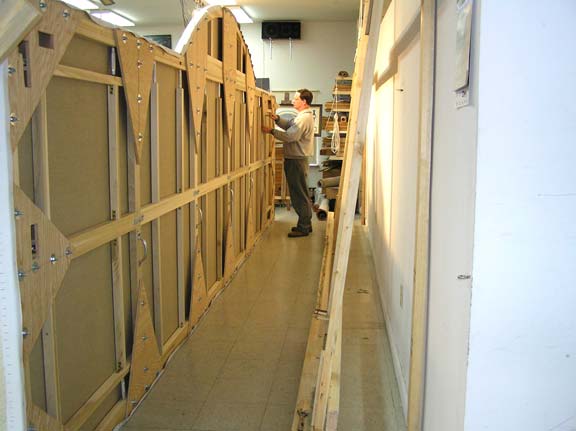
Here you can get an idea of the configuration of the stretcher system. I talked about the reason for the stretcher system before. However, let me review. I paint my murals on large canvas stretchers because after studying murals which were painted directly on the walls, I have found that a great deal of murals are lost over time. It is either too expensive or impossible to remove the work when the buildings are no longer useful. Thus, they are lost. My hope is that the development of a portable stretcher system will allow the work to survive as long as possible by simply moving the work to a new location. I also like to paint the mural in my studio and not have to travel to Cape to do the work. When the mural is complete, the canvas will be shipped to the River Campus and installed.
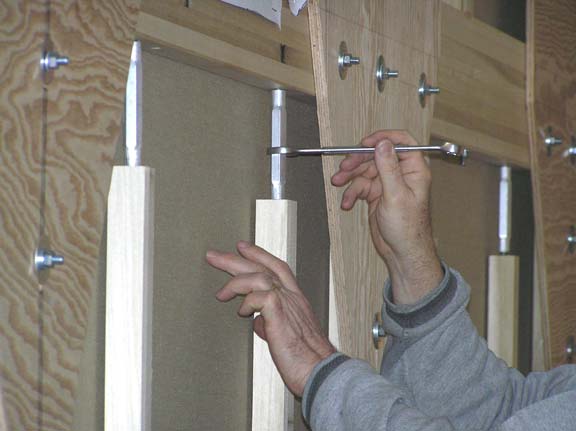
Tightening the canvas is like tuning a large drum. I am using a wrench to adjust one of the many turn buckles. I have removed the eyes from the ends of the turn buckles. And, I am using them to push not pull as is their normal function. As I turn the mechanism, the stretcher system will expand. The process is to turn, tap, and listen to feel and hear the torque being applied to the canvas.
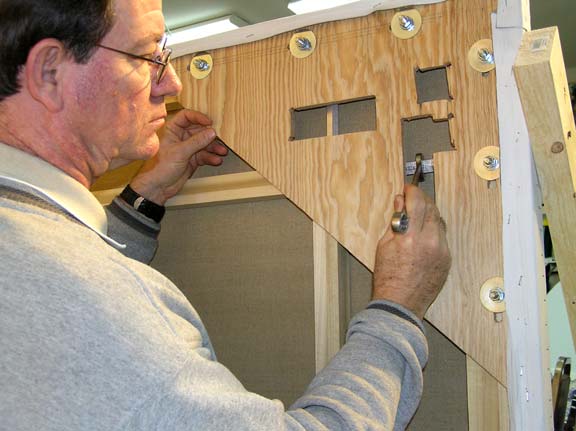
The corners get the same treatment. This process was repeated throughout the canvas stretcher system at 10am, 2pm, and once again at 10pm that evening. I want the canvas to tighten slowly. At 11pm that evening, I was a happy camper. Everything worked as it was planned on paper. The result was as good or better than I had hoped. The canvas is drum tight; and, a perfect surface on which to work.
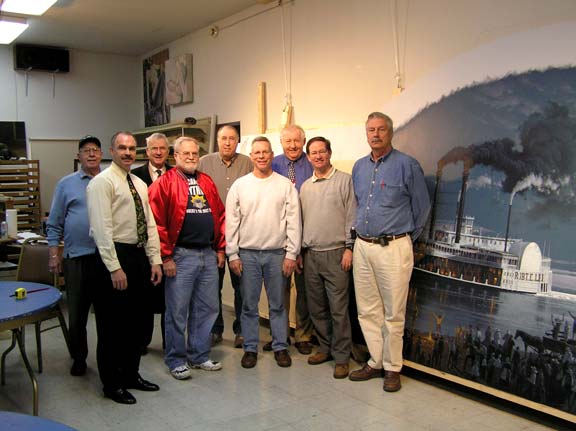
The next morning I got my coffee shop friends back on the job. The mural is back on the easel and ready for painting to continue. Thanks to my friends from left to right, front row: Bill Rennick, Gene Brez, Jim Gephardt, yours truly, John Fischer, back row: Paul "Pepe" LaPlant, Sid Thayer, Frank Wood, Terry Briggs. Many thanks to you, troops.
All the best to you,
